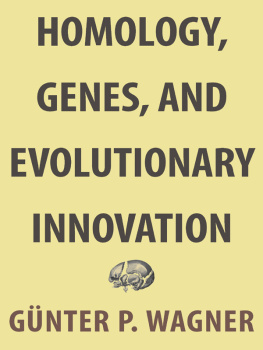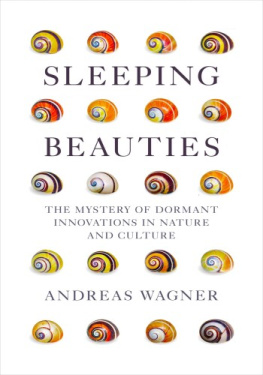Wagner - Homology, Genes, and Evolutionary Innovation
Here you can read online Wagner - Homology, Genes, and Evolutionary Innovation full text of the book (entire story) in english for free. Download pdf and epub, get meaning, cover and reviews about this ebook. City: Princeton, year: 2014, publisher: Princeton University Press, genre: Romance novel. Description of the work, (preface) as well as reviews are available. Best literature library LitArk.com created for fans of good reading and offers a wide selection of genres:
Romance novel
Science fiction
Adventure
Detective
Science
History
Home and family
Prose
Art
Politics
Computer
Non-fiction
Religion
Business
Children
Humor
Choose a favorite category and find really read worthwhile books. Enjoy immersion in the world of imagination, feel the emotions of the characters or learn something new for yourself, make an fascinating discovery.
- Book:Homology, Genes, and Evolutionary Innovation
- Author:
- Publisher:Princeton University Press
- Genre:
- Year:2014
- City:Princeton
- Rating:5 / 5
- Favourites:Add to favourites
- Your mark:
- 100
- 1
- 2
- 3
- 4
- 5
Homology, Genes, and Evolutionary Innovation: summary, description and annotation
We offer to read an annotation, description, summary or preface (depends on what the author of the book "Homology, Genes, and Evolutionary Innovation" wrote himself). If you haven't found the necessary information about the book — write in the comments, we will try to find it.
Homology, Genes, and Evolutionary Innovation — read online for free the complete book (whole text) full work
Below is the text of the book, divided by pages. System saving the place of the last page read, allows you to conveniently read the book "Homology, Genes, and Evolutionary Innovation" online for free, without having to search again every time where you left off. Put a bookmark, and you can go to the page where you finished reading at any time.
Font size:
Interval:
Bookmark:

Homology, Genes, and Evolutionary Innovation
Homology, Genes, and Evolutionary Innovation
Gnter P. Wagner
PRINCETON UNIVERSITY PRESS
Princeton and Oxford
Copyright 2014 by Princeton University Press
Published by Princeton University Press, 41 William Street, Princeton,
New Jersey 08540
In the United Kingdom: Princeton University Press, 6 Oxford Street,
Woodstock, Oxfordshire OX20 1TW
press.princeton.edu
The epigraph at the beginning of chapter 8 is reprinted by permission from Macmillan Publishers Ltd: Nature Reviews Genetics, The Evolution of Cell Types in Animals: Emerging Principles from Molecular Studies, by Detlev Arendt, vol. 9, number 11, copyright 2008.
All Rights Reserved
Library of Congress Cataloging-in-Publication Data
Wagner, Gnter P., 1954
Homology, genes, and evolutionary innovation / Gnter P. Wagner.
pages cm
Includes bibliographical references and index.
ISBN 978-0-691-15646-0 (hardcover : alk. paper) 1. Developmental genetics. 2. Evolution (Biology) 3. Genetic regulation. I. Title.
QH430.W335 2014
571.8'5dc23
2013025386
British Library Cataloging-in-Publication Data is available
This book has been composed in Minion Pro and Myraid Pro
Printed on acid-free paper
Printed in the United States of America
1 3 5 7 9 10 8 6 4 2
To my parents and all who,
through the years,
have sustained me
by their love and kindness,
their mentorship and encouragement.
CONTENTS
PREFACE
This book is the product of an intellectual journey that began in the spring term of 1972 when I first heard a talk given by my future dissertation mentor, Rupert Riedl. I was then a junior in a chemical engineering program, although my brother had encouraged me to attend a weekly seminar series on evolution given at the University of Vienna. Riedl was one of the speakers and had just returned from a five-year stint at the University of North Carolina. He had brought with him a manuscript of his major work on evolution, Order in Living Organisms (German: Die Ordnung des Lebendigen, 1975; English edition 1978). In that book as well as the seminar I attended, Riedl outlined a theory of evolutionary change that addressed many of the questions that, at the time, had been neglected in mainstream evolutionary theory. He laid out a vision of evolutionary biology that relied heavily on developmental considerations and anticipated the agenda of what later would become known as evolutionary developmental biology or, perhaps better, devo-evo. He also argued that the key to understanding macroevolutionary patterns was the origin and persistence of homologous body parts. Homology, the correspondence of body parts in sometimes distantly related organisms, is the key to understanding what the evolution of complex body plans is about. I immediately realized that this was an intellectual challenge that, at the very least, would keep me entertained for a lifetime.
This early fascination with questions of morphological evolution should have made me become a comparative anatomist, although that is not what I became. Even though I have a handful of strictly anatomical papers to my credit, the bulk of my work is in areas that are seemingly unrelated to morphology, including population genetic theory, molecular evolution, developmental evolution and, more recently, the molecular biology of gene regulation. This came about because, as I was taught by Riedl, the questions raised by the patterns of morphological evolution are broader and deeper than the morphological patterns themselves. They raise questions regarding developmental constraints and evolvability, the evolution of gene regulatory networks, and many others. To take these problems seriously, the researcher is drawn to various fields that seem to be far afield from traditional morphology. And so is the narrative offered in this book.
It may seem strange to some to find chapters with a conceptual focus and even a philosophical focus side-by-side with chapters on gene regulation and transposable elements or transcription factor biochemistry. However, I could not see a way of talking about these issues by leaving out one or the other of these directions: the conceptual or the molecular and mechanistic. Biology is the science of a holistic phenomenon (life) and even any reasonably complex aspect of biology tends to require knowledge in several fields. Any other way would shortchange the subject of study.
There is no broad consensus, nor even a narrow consensus on the subject of homology and its mechanistic foundations. For this reason and by necessity, the perspective developed in this book is a very personal one derived from decades of thinking and research on this topic and topics related to it in various ways. I draw mostly on papers that influenced me at certain stages of my intellectual development, and the research done in my lab and with collaborators. Thus, the references I have cited are highly biased toward these sources. It would have been impossible for me to do justice to the sprawling literature that underpins the many areas of research on homology, developmental evolution, the evolution and molecular biology of gene regulation, population genetics of modularity, and many more. I tried to be fair to differing views, although I am certain that I failed in many instances and I apologize for any oversights and misrepresentations. I can only hope that vigorous debate will ultimately correct these flaws in my presentation.
Every biologist will agree that homology is a confused and confusing subject. To forge a view on this subject that reduced the confusion, at least to the satisfaction of this author if nobody elses, was a feat that depended on the contributions of and the interactions with a great many people, beginning with my doctoral and postdoctoral mentors Rupert Riedl (Vienna), Peter Schuster (Vienna), Joachim Wolff (Gttingen), and Alfred Gierer (Tbingen). This also includes colleagues and students throughout the last decades with whom I had the privilege of working in biological research and teaching. To be comprehensive would necessitate a very long list. However, I must mention a few who, lately, have been wonderful companions and sources of inspiration. I must acknowledge my colleagues at Yale: Frank Ruddle, Michael Donoghue, Richard Prum, Leo Buss, Steve Stearns, Jacques Gauthier, and Paul Turner. Colleagues and friends at other institutions with whom I shared part of the journey include James Cheverud, Ron Amundson, Roberto Romero, Reinhard Brger, Benedikt Hallgrimmsson, Gerd Mller, Peter Stadler, Chris Amemiya, Walter Fontana, Joe Thornton, Lee Altenberg, Mihaela Pavliev, Ingo Brigandt, Alan Love, and many more. Of course, the closest associates are always former and current members of ones academic family, my students and postdocs, including Bernhard Misof, Andreas Wagner, Manfred Laubichler, Thomas Hansen, Hans Larsson, Joachim Hermisson, Karen Crow, Alex Vargas, Chi-hua Chu, Vincent (Vinny) Lynch, Mauris Nnamani, Deena Emera, Jake Musser, Koryu Kin, and many others. I want to specifically acknowledge my colleagues who helped me by providing comments on the draft of this manuscript: Mihaela Pavliev, Thomas Hansen, Alessando Minelli, Peter Godfrey-Smith, Ingo Brigandt, and Koryu Kin. Their critical eyes and incisive questions, more often than not, helped me avoid premature convergence. My gratitude goes to all of those people, both mentioned and unmentioned by name, for their incredible generosity. Finally, I thank my editor at Princeton University Press, Alison Kalett, for her patience and guidance through the publication process of this project.
Next pageFont size:
Interval:
Bookmark:
Similar books «Homology, Genes, and Evolutionary Innovation»
Look at similar books to Homology, Genes, and Evolutionary Innovation. We have selected literature similar in name and meaning in the hope of providing readers with more options to find new, interesting, not yet read works.
Discussion, reviews of the book Homology, Genes, and Evolutionary Innovation and just readers' own opinions. Leave your comments, write what you think about the work, its meaning or the main characters. Specify what exactly you liked and what you didn't like, and why you think so.
















